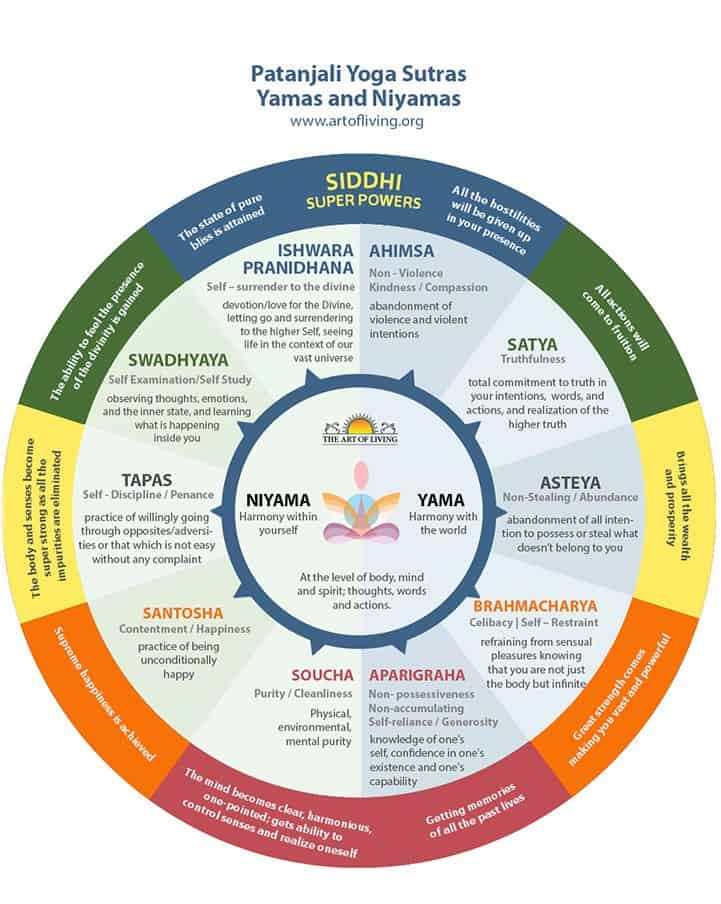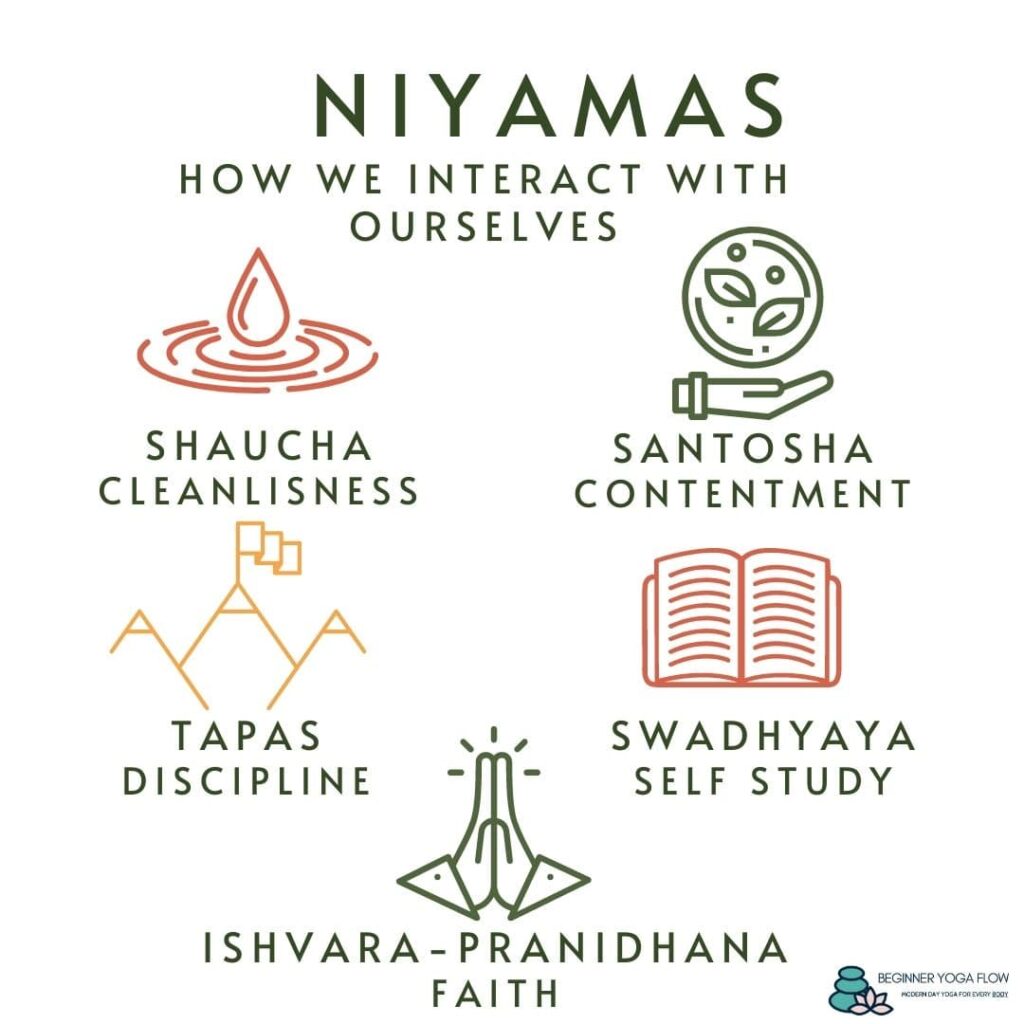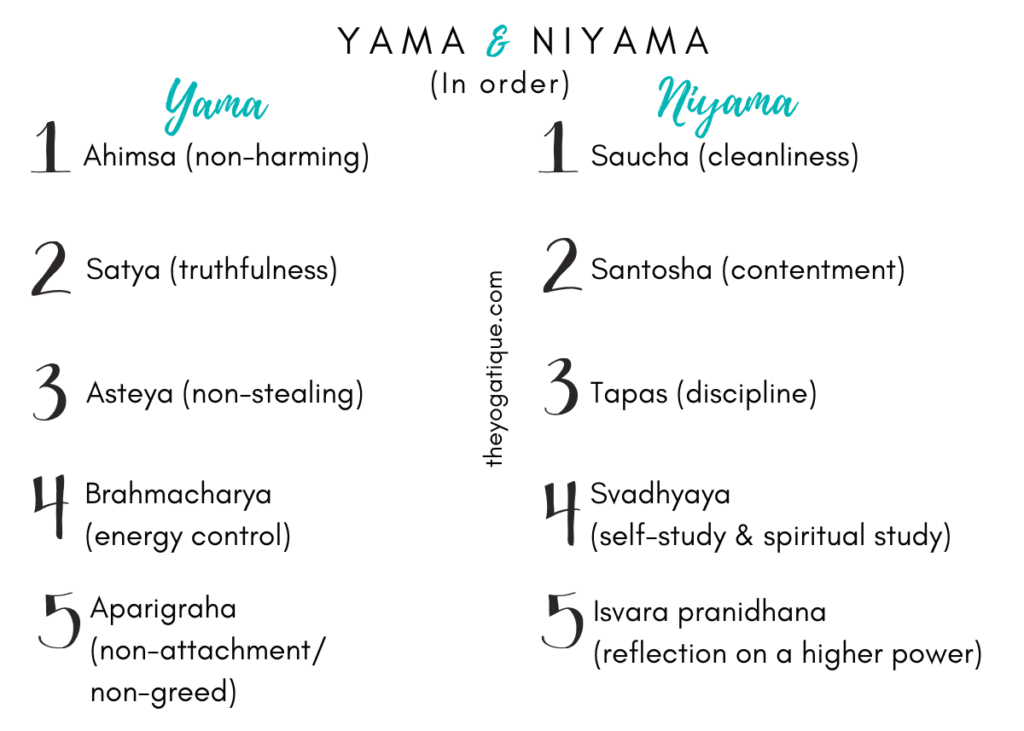
The Purpose of Yama and Niyama Yoga with Eve Grzybowski
The 5 Yamas are Ahimsa (nonviolence), Satya (truthfulness), Asteya (non-stealing), Brahmacharya (abstinence), and Aparigraha (non-accumulation), whereas the 5 Niyamas are Soucha (internal and external cleanliness), Santosha (happiness and contentment), Tapas (penance), and Swadhyaya (self-study). The Yamas are concerned with our acts in social.

Yamas & Niyamas Yoga Eight Limbs of Yoga Archival Etsy Eight limbs
The ultimate goal: to help practitioners cultivate a steady mind, leading toward everlasting contentment. The yamas (social, ethical restraints) and niyamas (self-disciplines) are the first two stops on the path. These ethical principles guide how we relate to other people and how we take care of ourselves.

Understanding Between Lord Yama and Yoga Yama and Niyama
The second limb of the 8 limbs of yoga, Niyama, usually refers to internal duties. The prefix 'ni' is a Sanskrit verb which means 'inward' or 'within'. There are five Niyamas: saucha (cleanliness), santosha (contentment), tapas (discipline or burning desire or conversely, burning of desire), svadhyaya (self-study or self-reflection.

The Yamas and Niyamas 8Limbs of Yoga Sri Sri Yoga Teacher Training
Niyamas: Observances, rules, and guidelines. The Yoga Sutra describes five different niyamas, including saucha (cleanliness), santosha (contentment), tapas (self-discipline), svadhyaya (self-reflection), and ishvarapranidhana (surrender to a higher power). 3. Asana: Yoga postures or poses.

The Yamas and Niyamas List Yoga Yamas and niyamas, Yoga sutras
Yamas and Niyamas may serve as guides to provide you a pathway on your spiritual journey, but the way you act and react to your environment and inner experiences will ultimately dictate your own discoveries and realizations. Most often, people find one of the 10 practices particularly challenging for them. So if you find yourself in that.

Yama e Niyama Consigli e bisbigli
ISBN 978-8131301722. Yama is a "moral restraint" or rule for living virtuously. Ten yamas are codified in numerous scriptures, including the Hatha Yoga Pradeepika compiled by Yogi Swatmarama, while Patanjali lists five yamas and five niyamas (disciplines) in the Yoga Sutras. ^ Weiss, Debra (2006).

Yama Niyama Print Yoga Wall Art Asthtanga Yoga Poster 8 Limbs Etsy
Learning to integrate the full "on and off the mat" practice including observing the five Yamas and Niyamas —yoga's guide on social and personal ethics— in your daily life can transform you and your yoga practice. Our thoughts, actions, decisions, interactions with others, our daily routines, our surroundings, everything can reflect.

Understanding the Niyamas and Yamas BEGINNER YOGA FLOW
The yamas and niyamas are yoga's ethical guidelines laid out in the first two limbs of Patanjali's eightfold path. They're like a map written to guide you on your life's journey. Simply put, the yamas are things not to do, or restraints, while the niyamas are things to do, or observances. Together, they form a moral code of conduct.

yamas and niyamas Yamas and niyamas, Yoga sutras, Eight limbs of yoga
The Yamas and Niyamas are like the "rules of the game". As you read, I encourage you to figure out how they can be applied to your personal yoga practice, both on and off the mat. "Yamas - These 5 principles have mostly to do with our behavior and thinking toward other beings" Ahimsa. No-harming, non-violence or, maybe more practical.

What Are The Yamas And Niyamas
NIYAMAS — The 10 Vedic Observances. Niyamas, how we interact with ourselves, our internal world.The practice of Niyama harnesses the energy generated from our practice and cultivation of the yamas.Niyama is about self-regulation — helping us maintain a positive environment in which to grow. The five niyamas are: hri, santosha, dana, astikya, ishvarapujana, siddhanta shravana, mati, vrata.

Namaste Yogi's, here are Yoga's ethical guide to living The Yamas and
The steps of each yama and niyama are cumulative — each discipline prepares you for the next. Read on for a deeper exploration of each of the yamas and niyamas. The Eight Limbs of Yoga. Around 150 BCE, the sage Patanjali outlined eight steps to living well in the classical Indian yoga text, the "Yoga Sutras."

The Luminescent The Yamas and Niyamas Medieval and Modern Views
The yamas and the niyamas are the first two limbs (parts) of the eightfold system for spiritual practice, as outlined by Patanjali in the Yoga Sutra.. The first limb is composed of five external observances (yamas), which can be seen as guidelines for navigating one's worldly conduct. The second limb lists five internal observances (niyamas), which are guidelines for navigating the.

The eight limbs of yoga Yamas and niyamas
The second limb of Patanjali's eight-limbed yoga system contains the five internal practices of Niyama (observance). These practices extend the ethical codes of conduct provided in his first limb, the Yamas, to the practicing yogi's internal environment of body, mind, and spirit.The practice of Niyama helps us maintain a positive environment in which to thrive and gives us the self.
Yama and Niyama THE HINDU PORTAL Spiritual heritage Rituals and
The first two stops on the path, even before the physical postures called asana, are ethical principles that are supposed to guide how we relate to other people and how we take care of ourselves. They're called the yamas (social restraints) and the niyamas (self-disciplines). Read Meditations from the Mat: Daily Reflections on the Path of Yoga.

Yama Niyama Meaning The Dos & Don'ts According To Ancient Yoga Philosophy
The Yamas and Niyamas originate from the very well known text 'The Yoga Sutras of Patanjali', which many yoga teachers or teachers-in-training will have attempted to decipher at some point. Patanjali is known as a sage, but it's very unlikely that one man wrote these texts - and far more likely that the texts are the culmination of what a group of Patanjali's disciples wrote over a.

Pin on Yamas and Niyamas
The yamas and niyamas are a significant part of yoga philosophy, introduced by Patanjali in the ancient text " The Yoga Sutras ", part of the Eight Limbs of Ashtanga yoga. I believe the best explanation of the yamas and niyamas is 'moral codes' or suggestions on 'right living.'. Some yogis refer to them as the 'ten commandments of.